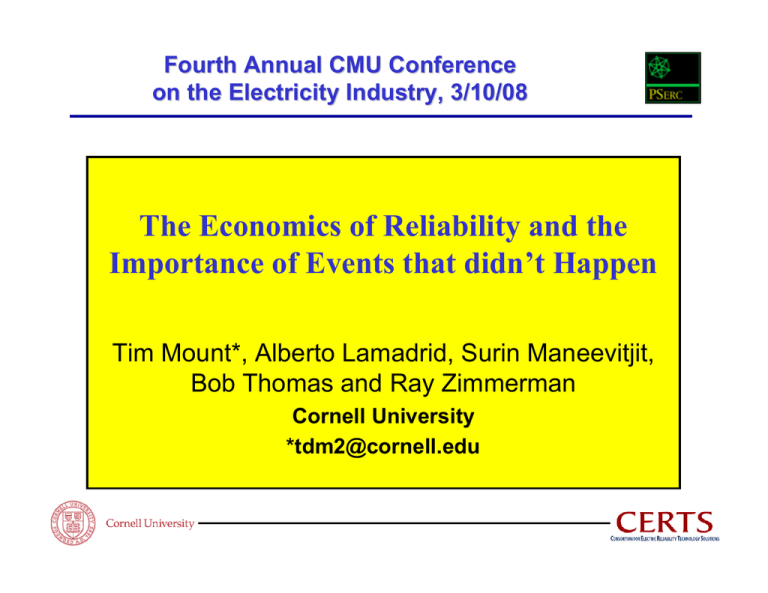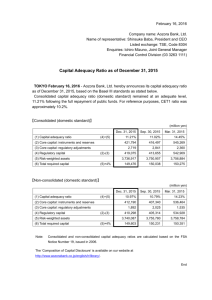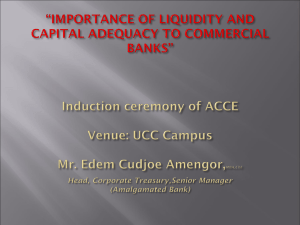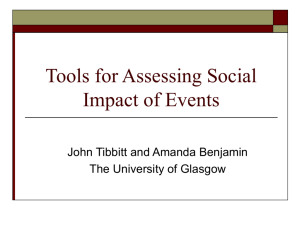The Economics of Reliability and the Bob Thomas and Ray Zimmerman
advertisement

Fourth Annual CMU Conference on the Electricity Industry, 3/10/08 The Economics of Reliability and the Importance of Events that didn’t Happen Tim Mount*, Alberto Lamadrid, Surin Maneevitjit, Bob Thomas and Ray Zimmerman Cornell University *tdm2@cornell.edu OBJECTIVE AND OUTLINE • OBJECTIVE – To develop an economic/engineering framework for evaluating the ability of a transmission network to respond to contingencies without loss of load (i.e. maintain operating reliability). – Use this common framework to address 1) operating reliability in real time, and 2) planning for additions to network capacity. • OUTLINE – PART 1: The typical regulatory approach to reliability using proxy standards for operating and planning purposes, such as setting reserve margins for generating capacity and DC approximations. – PART 2: Description of the “Super OPF” developed at Cornell University that uses co-optimization for the intact system and a set of credible contingencies. – PART 3: An example of how to determine the economic benefits of redundancy by avoiding unscheduled loss of load when contingencies occur. Page 2 PART 1 The Typical Regulatory Approach to Establishing Proxy Standards For Reliability Page 3 Current Reliability Standards Two Different NERC Criteria DEFINITIONS OF RELIABILITY North-American Electric Reliability Council (NERC) 1. Adequacy — The ability of the electric system to supply the aggregate electrical demand and energy requirements of customers at all times, taking into account scheduled and reasonably expected unscheduled outages of system elements. [Ensuring there is enough generation and transmission capacity --- the investors’ problem] 2. Operating Reliability — The ability of the electric system to withstand sudden disturbances such as electric short circuits or unanticipated failure of system elements. [Determining the dispatch of installed capacity and levels of reserves --- the system operators’ problem] Page 4 An Example of How System Adequacy is Maintained in New York State – Transmission Adequacy is accomplished through a conventional planning process that is driven largely by concerns about reliability (a less formal process than the earlier procedures used under traditional regulation), and merchant transmission is encouraged. – Generation Adequacy is treated as an effective proxy for maintaining NERC/FERC standards of Operating Reliability given the the projected structure of the transmission network. – Locational requirements for generation capacity are treated as an effective proxy for the limitations of the transmission network, and specifying these requirements is the primary responsibility of regulators. – Projections of peak load in different zones of the state determine how much generation capacity is needed, and an analysis is conducted using standard GE models to confirm that the NERC/FERC standards of Operating Reliability can be met by this much capacity. – Load Serving Entities (LSE) are required to hold contracts for enough generation capacity to meet their own forecasted peak load plus the required reserve margin in their location i.e. the final responsibility for maintaining generation adequacy is decentralized. Page 5 An Example of the Standards for Generation Adequacy in New York State Locational Capacity Requirements for New York State in 2005/06 Forecasted Peak Load MW Locational ICAP % of Peak Required Locational ICAP , MW Actual ICAP , MW NYC 11,315 80 9,052 LI 5,231 99 NYCA 31,692 118 Locality 9,887 Actual ICAP % of Peak 87 Ratio of Actual ICAP to Required 1.09 5,179 5,318 102 1.03 37,715 39,647 125 1.05 Source: NYISO 2/17/05 NYC LI NYCA New York City (J) Long Island (K) New York Control Area Page 6 Power Transfers in New York State Ranked Nodal Prices in NYCA for 2000 Page 7 Power Transfers in New York State 3. Ranked Nodal Prices in NYCA for 2005 Page 8 Limitations of Current Practices • The use of DC approximations for AC constraints (e.g. tighter thermal limits on transmission to approximate voltage constraints) may approximate the optimal physical dispatch BUT the corresponding nodal prices are WRONG when the network is stressed. • This is exactly the time when correct prices are the most informative for identifying weaknesses of a given network. • Proxy limits for planning system adequacy (e.g. reserve margins for generating capacity) hide the real weaknesses on a network. Page 9 PART 2 The Structure of the SuperOPF Page 10 Contributors to Developing the Super Optimal Power Flow (OPF) • • • • • • Alberto Lamadrid Carlos Murillo-Sánchez Robert Thomas Hongye Wang Zhifang Wang Ray Zimmerman Page 11 What is the SuperOPF? Determining the optimal power flows for operations and planning on an AC network are computationally complex due to many non-linear constraints (Kirkoff’s Laws). Traditional Approach SuperOPF Break into manageable sub-problems using DC approximations Use a full AC network in a single mathematical programming framework. sequential optimization using proxy constraints co-optimization of the dispatch with explicit contingencies incorrect prices correct prices Page 12 Contingencies Contingency 1 Base Case Contingency 2 .. . Contingency k Page 13 Capabilities of the SuperOPF • • • • • • • Determines the OPF for a full AC non-linear network model plus other constraints e.g. limits on emissions Incorporates n–1 contingency security with static and dynamic constraints Determines the supply of active and reactive energy and geographically distributed reserves for maintaining Operating Reliability Allows for the uncertainty of demand, wind and contingencies Determines the correct prices for day-ahead contracts for energy, reactive supply and reserves Provides a consistent mechanism for subsequent redispatching and pricing when uncertain quantities, such as the pattern of load, are known The same analytical framework can be used for planning purposes to identify potential weaknesses on the network Page 14 Potential Applications • • • • • • Modeling Day-Ahead energy and reserve markets followed by consistent real-time balancing Analyzing environmental policies that limit the allowed levels of emissions in different regions Evaluating uncertain energy sources such as wind, river flow, solar, and microgrids Solving for a sequence of dispatches to find a feasible restoration path following a disturbance Extending current studies of public/private goods to include transmission constraints on a full AC network Planning optimal investments in generation and transmission capacity to maintain System Adequacy All with the correct prices Page 15 PART 3 Determining the Economic Benefits of Avoiding Loss-of-Load during Contingencies: An Example Page 16 The Expected Cost of Lost Load Page 17







